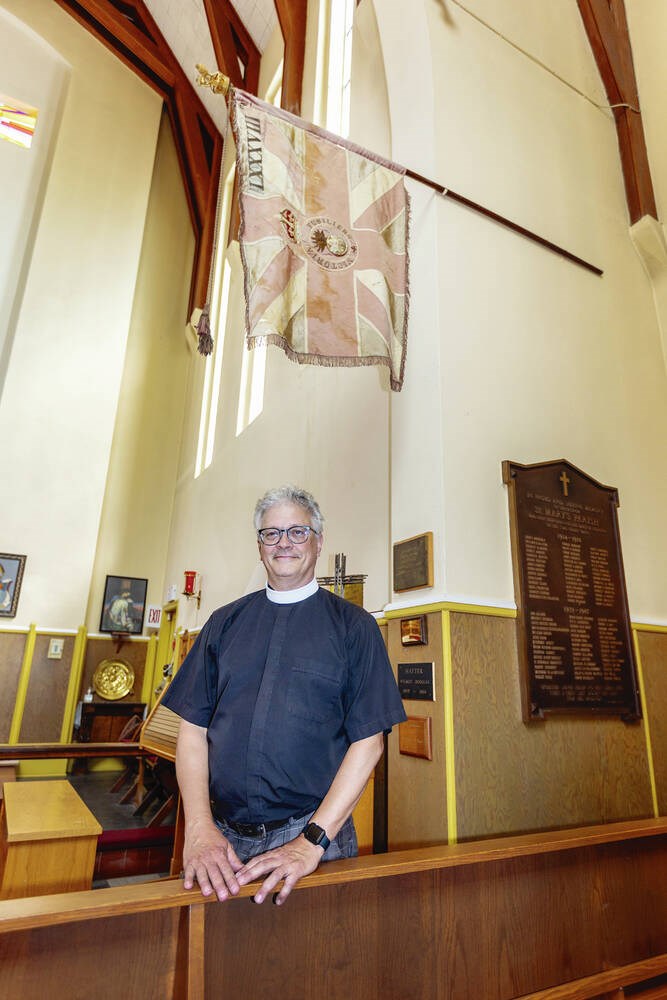Two fading military flags that have hung inside an Oak Bay church for more than a century are heading to a museum.
The retired colours of the 88th Regiment Victoria Fusiliers have been in St. Mary’s Anglican Church since 1920. The flags represent the volunteer soldiers recruited in Victoria who fought in the First World War and saw action in the bloody battles at Ypres, Festubert and Langemarck.
The colours will be transferred for preservation and display at the Canadian Scottish Regimental Museum at the Bay Street Armoury.
Rev. Canon Craig Hiebert will preside over a handover ceremony at St Mary’s chapel, 1701 Elgin St., on Saturday at 1 p.m. that will include representatives of the Canadian Scottish Regiment (Princess Mary’s) and a piper from the regiment. The ceremony is open to the public.
Hiebert said in an interview that it was tradition of the time that the Fusiliers’ colours were consecrated by the Anglican Church — the Church of England — and kept there. Rev. George Andrews, rector of St. Mary’s,did so in a ceremony at the 88th Regiment’s Willows Camp on the Lansdowne slope near Willows Beach in early 1916.
Andrews served as the regiment’s chaplain and went overseas with 1,100 officers and men as part of the 88th Battalion Canadian Expeditionary Force, leaving Victoria Harbour on May 23, 1916.
Accounts in the Daily Colonist at the time showed an overflowing ship of soldiers and thousands of onlookers cheering their departure as the British Empire strengthened its ranks in the escalating war. The sendoff was described as “one of the most inspiring that has been seen here since the beginning of the war.”
At the end of the First World War, when Andrews and others from the 88th Battalion returned to Victoria, t St. Mary’s Church held a memorial service.
The colours of the 88th were given to the church to be hung in the chancel. In 1951 they were taken down when the church was being rebuilt and renovated, but were returned to their standards shortly after.
Hiebert said the colours were not taken into battle. “If they were lost, it could dishearten the soldiers or hearten the enemy,” said Hiebert.
Regimental colours, he said, should traditionally hang until they naturally fall off their standards. The flags, though fading from sunlight and long exposure to dust and time, won’t be given any special preservative measures, he said.
“Our intention is only to preserve them longer in a natural state,” said Hiebert. “They can’t be restored by an act of parliament and are intended to decay.”
According to an online history of the regiment by Geoffrey Hendrie and Nathan Waller in collaboration with the University of Victoria, the Victoria Fusiliers became a significant recruitment unit and many of its men were transferred to other battalions. It was reported in the Daily Colonist the Fusiliers supplied 45% of the officers and men of the 30th Battalion; 50% of the men and 35% of the officers of the 48th Battalion; and 105 men and three officers of the 62nd Battalion.
The Daily Colonist also said it was worthy to note that the Fusiliers had “the distinction of sending overseas the tallest officer of the British Empire, in the person of Lieutenant Wilson, who is 6 ft 8 1/4, in height and who is with the 54th Battalion as one of its signalling officers.”
The First World War ended in 1918 and the Victoria Fusiliers continued to meet until 1920. On March 15, 1920 a general order reorganized Victoria’s 88th and 50th regiments into the Canadian Scottish Regiment.
>>> To comment on this article, write a letter to the editor: [email protected]



